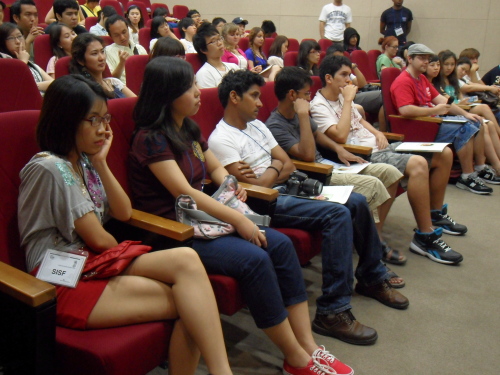“Isn’t it detrimental to animals in the Hangang parks if waste buried underground still remains there?”
This was one of the questions asked on July 26, by a foreign student after a city official at the World Cup Park Management Office made a presentation about how a giant landfill in Seoul has been transformed into several eco-parks.
The 60 international students who gathered that day are members of the Seoul International Student Forum, which is run by the Seoul Metropolitan Government every year in a bid to generate ideas and suggestions and further integrate them into the city’s policies. The forum members come up with policy proposals to help Seoul provide a more convenient living environment for foreigners and expats and become truly globalized.
This was one of the questions asked on July 26, by a foreign student after a city official at the World Cup Park Management Office made a presentation about how a giant landfill in Seoul has been transformed into several eco-parks.
The 60 international students who gathered that day are members of the Seoul International Student Forum, which is run by the Seoul Metropolitan Government every year in a bid to generate ideas and suggestions and further integrate them into the city’s policies. The forum members come up with policy proposals to help Seoul provide a more convenient living environment for foreigners and expats and become truly globalized.

To witness how Seoul is carrying out its administrative affairs in areas such as IT and the environment, SISF members have visited city government organizations and agencies such as Digital Media City, Dongdaemun Design Park and Arisu Water Treatment Plant so far.
Tuesday’s schedule was designed to explore the city’s promotion of green growth in areas including World Cup Park Management Office and Mapo Resource Recovery Plant.
The student who asked the question got an answer. Once a landfill area containing 92 tons of garbage, Nanji Island became the World Cup Park after the waste was covered with a one-meter layer of impermeable plastic liners and then topped off with soil. This three-layer bed in the eco-parks, including Noeul Park and Haneul Park, keeps bad odors and harmful gases from escaping.
Riding around Haneul Park on an electric vehicle, the group went on a tour to see how the park was created, while enjoying the scenic views and various artistic sculptures that the former mountain of garbage now has to offer.
Following the tour, the members headed to Mapo Resource Recovery Plant. The plant incinerates 650 to 680 tons of garbage a day from neighboring residential areas, generating power to supply heating and hot water to apartment complexes. The foreign students were able to see the garbage collected and heavy cranes used to load garbage into the incinerator.
“I heard about Nanji Island before but did not know how exactly it was created,” said Dirshan Adhikari Lalana, a member from Sri Lanka. He said he appreciated the opportunity to ask questions to officials face-to-face and learn about resource recovery technology in detail.
Seoul is expanding green spaces and working to enhance water and air quality and is focusing more and more on waste management. In highly advanced facilities, this plant transforms the toxic emissions caused by waste incineration into a source of energy. According to an official at Mapo Resource Recovery Plant, the heat generated by the incinerator is sent to neighboring residential areas, supplying heating and hot water, while the ash created at the bottom of the incinerator is made into bricks for sidewalk paving in the city.
He went on to say that harmful gases including dioxins and exhaust gas generated during incineration are refined by going through filters and most pollutants such as heavy metals, acidic gases and nitrogen oxides are purified through this process.
Many of the students showed a great interest in the plant and the incinerator, especially those from countries without such systems or governments carrying out policies related to environment.
Bushan Kumar, a student from India and vice president of the forum said, “It is great I could observe the operating procedures and facilities in the resource recovery plant.”
He expressed his hope to see a similar system in his hometown.
During the tour, the visitors asked questions such as what benefits residents in the neighboring area have received since the plant was built and whether any significant changes have been made in terms of the environment.
An official at the Seoul Global Center said the forum’s next trips will include more municipal organizations such as the Seoul Transportation Operation Information Service and Korea Smart Card Co. which runs the T-money system.
Based on what they learn through field trips to city organizations, the student members will propose ideas and suggestions on how to make Seoul more livable for both Seoul citizens and international residents. From their suggestions, the most practical will be selected and implemented in the city’s municipal policies. The final policy proposals will be presented at the SISF General Assembly scheduled for Aug. 26.
By Michelle Kang
Michelle Kang is an editor at the Seoul Global Center. She can be reached at michyk@sba.seoul.kr ― Ed.







![[Graphic News] More Koreans say they plan long-distance trips this year](http://res.heraldm.com/phpwas/restmb_idxmake.php?idx=644&simg=/content/image/2024/04/17/20240417050828_0.gif&u=)
![[KH Explains] Hyundai's full hybrid edge to pay off amid slow transition to pure EVs](http://res.heraldm.com/phpwas/restmb_idxmake.php?idx=644&simg=/content/image/2024/04/18/20240418050645_0.jpg&u=20240419100350)





![[From the Scene] Monks, Buddhists hail return of remains of Buddhas](http://res.heraldm.com/phpwas/restmb_idxmake.php?idx=652&simg=/content/image/2024/04/19/20240419050617_0.jpg&u=20240419175937)

![[KH Explains] Hyundai's full hybrid edge to pay off amid slow transition to pure EVs](http://res.heraldm.com/phpwas/restmb_idxmake.php?idx=652&simg=/content/image/2024/04/18/20240418050645_0.jpg&u=20240419100350)

![[Today’s K-pop] Illit drops debut single remix](http://res.heraldm.com/phpwas/restmb_idxmake.php?idx=642&simg=/content/image/2024/04/19/20240419050612_0.jpg&u=)